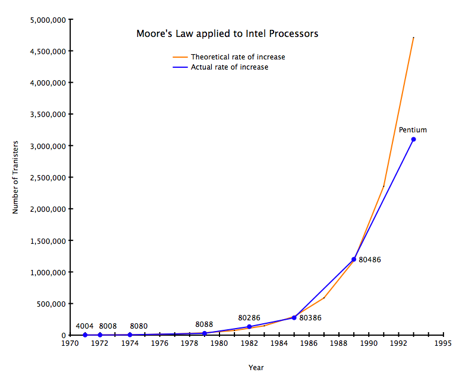Moore's Law || Moore's Law Part 1
What is Moore's Law?
Moore's law was formulated by Gordon Moore, the CEO of Intel, in 1965. According to the rigid formalism of science, Moore's law is not a law but a prediction based on the behavior of transistors over the years leading up to 1965. It turned out to be accurate through observations and developments made in the following years.
The "law" states that the number of transistors per unit area of integrated circuits, and thus the computational power, will double every year or so. It was based on the same observation made every year after the invention of the integrated circuit.
Revision of the Estimation
In 1975. the rate of innovation in the scaling down process of the transistor fell - compelling Moore to revise the forecast to doubling every 2 years.
Intel executive, David House expressed Moore's law in terms of data density and transmitting rate in the form of another pseudo law with the time period of 18 months. He stated that the number of basic processes, the computational power of the transistor ensemble, which could be conducted on an IC within 1 second would double every 18 months.
Innovations That Led To The Moore's Observation
1.The development of CMOS in 1963
Through the use of symmetric and complementary p-type and n-type channel transistors, the circuits that are designed using CMOS only dissipate power during the switching of states. This creates a situation where the static power dissipation is almost zero. This allowed the integration of more transistors onto a chip-board.
2. The development of DRAM (Dynamic Random Access Memory) in 1967
DRAM is a type of random access (volatile) semiconductor memory in which each bit of information is stored in a tiny capacitor with the charged state representing '1' and the discharged state representing '0'. Due to the phenomenon of charge leakage from capacitors, these capacitors had to be restored to their original charge in a periodic manner, The circuits which were used for charge restoration are known as memory refresh circuits. The dynamic maintenance of charge earned this type of memory its name.
DRAM used tiny capacitors whose size was smaller than the flip-flops used in Static-RAM. This led to further miniaturization in the size of ICs by the invention of single transistor memory cells.
3. The advent of flash memory in the early 1980s
Flash memory is a non-volatile electric memory that is similar to EEPROM in the sense that it can be electrically erased and programmed. The high speed and data density of flash memories comes at the cost of the size of its erase blocks and the number of read cycles it can undergo. However the increase in the speed and the density of flash memories was a major factor in the maintenance of Moore's law.
References
1. Webopedia
2. Techopedia
3 .CMOS
4. The End Of Moore's Law
Moore's law was formulated by Gordon Moore, the CEO of Intel, in 1965. According to the rigid formalism of science, Moore's law is not a law but a prediction based on the behavior of transistors over the years leading up to 1965. It turned out to be accurate through observations and developments made in the following years.
The "law" states that the number of transistors per unit area of integrated circuits, and thus the computational power, will double every year or so. It was based on the same observation made every year after the invention of the integrated circuit.
Revision of the Estimation
In 1975. the rate of innovation in the scaling down process of the transistor fell - compelling Moore to revise the forecast to doubling every 2 years.
Intel executive, David House expressed Moore's law in terms of data density and transmitting rate in the form of another pseudo law with the time period of 18 months. He stated that the number of basic processes, the computational power of the transistor ensemble, which could be conducted on an IC within 1 second would double every 18 months.
Innovations That Led To The Moore's Observation
1.The development of CMOS in 1963
Through the use of symmetric and complementary p-type and n-type channel transistors, the circuits that are designed using CMOS only dissipate power during the switching of states. This creates a situation where the static power dissipation is almost zero. This allowed the integration of more transistors onto a chip-board.
2. The development of DRAM (Dynamic Random Access Memory) in 1967
DRAM is a type of random access (volatile) semiconductor memory in which each bit of information is stored in a tiny capacitor with the charged state representing '1' and the discharged state representing '0'. Due to the phenomenon of charge leakage from capacitors, these capacitors had to be restored to their original charge in a periodic manner, The circuits which were used for charge restoration are known as memory refresh circuits. The dynamic maintenance of charge earned this type of memory its name.
DRAM used tiny capacitors whose size was smaller than the flip-flops used in Static-RAM. This led to further miniaturization in the size of ICs by the invention of single transistor memory cells.
3. The advent of flash memory in the early 1980s
Flash memory is a non-volatile electric memory that is similar to EEPROM in the sense that it can be electrically erased and programmed. The high speed and data density of flash memories comes at the cost of the size of its erase blocks and the number of read cycles it can undergo. However the increase in the speed and the density of flash memories was a major factor in the maintenance of Moore's law.
References
1. Webopedia
2. Techopedia
3 .CMOS
4. The End Of Moore's Law

Comments
Post a Comment